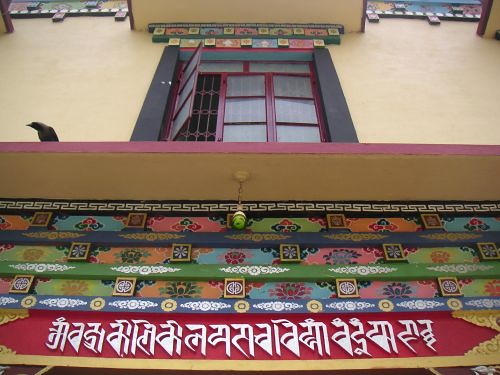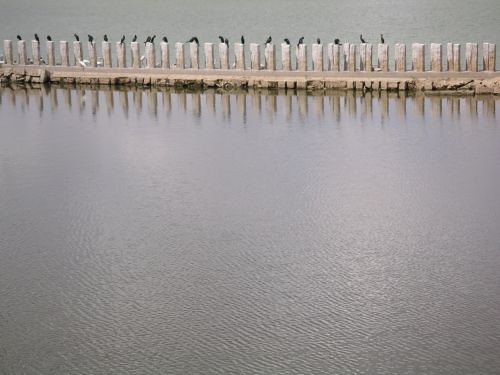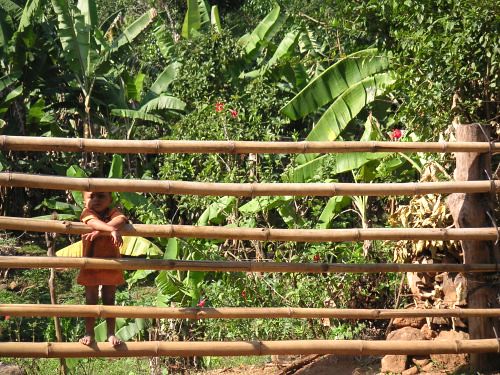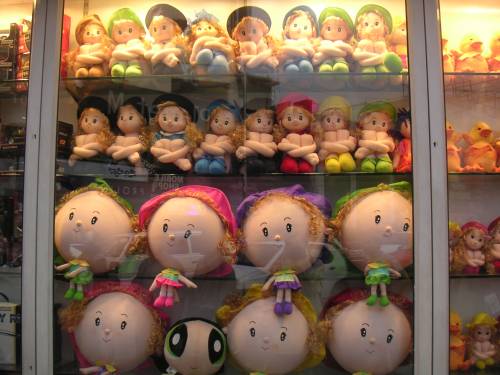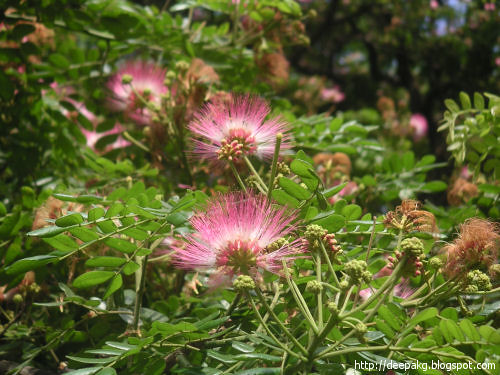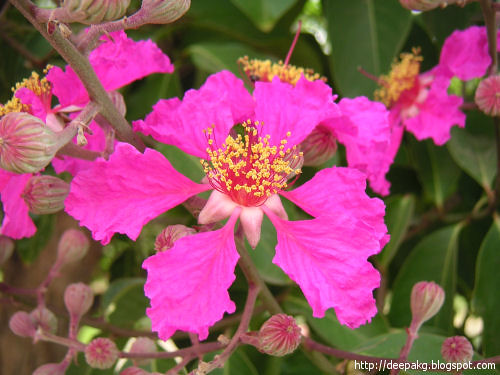hints, allegations and things left unsaid...
New blog template
As an owner of this blog, it is my moral obligation to dress it with in a new template. Even more so because it will shortly turn two and its old clothes were beginning to look, well, old.
I had thought of doing a new template some two weeks ago, but at that time I had no clue as to what its final visual appearance would be. The current design was gifted to me by a fleeting flash of creativity, while I was browsing through the recent Coorg pictures. (Advice to myself: travel more).
The colorful mask, that dominates the header graphic, adorned the roof of a temple that we had visited on our descent from Talacauvery (the purported origin of the Cauvery River). I knew I had to use it, when I spotted the little sparrow perched on it, which displayed the élan of a Alfred Brendel performing first movement of moonlight sonata for the three hundredth time; despite the mask’s daunting appearance. And if you aren’t quite used to thinking in metaphors, the mask signifies ‘hints, allegations’ while the sparrow has been chosen as my insignia for ‘things left unsaid’.
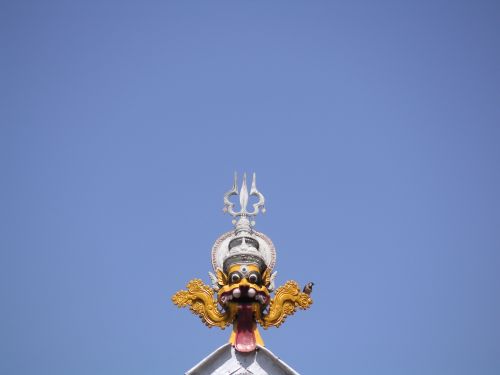
The jagged border again comes from a picture. The wooden stripes of wedges decorated the perimeters of the slanting, wooden, temple roofs:
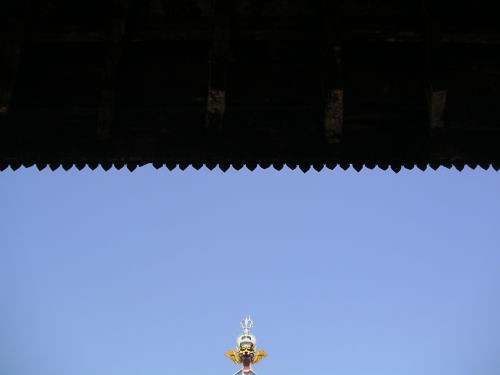
The text, of course, was added in my favorite photo editing program: Paint Shop Pro.
More on this inspiring temple will follow shortly (as soon as I overcome my current resistance that hinders the completion of my birthday travelogue).
I had thought of doing a new template some two weeks ago, but at that time I had no clue as to what its final visual appearance would be. The current design was gifted to me by a fleeting flash of creativity, while I was browsing through the recent Coorg pictures. (Advice to myself: travel more).
The colorful mask, that dominates the header graphic, adorned the roof of a temple that we had visited on our descent from Talacauvery (the purported origin of the Cauvery River). I knew I had to use it, when I spotted the little sparrow perched on it, which displayed the élan of a Alfred Brendel performing first movement of moonlight sonata for the three hundredth time; despite the mask’s daunting appearance. And if you aren’t quite used to thinking in metaphors, the mask signifies ‘hints, allegations’ while the sparrow has been chosen as my insignia for ‘things left unsaid’.

The jagged border again comes from a picture. The wooden stripes of wedges decorated the perimeters of the slanting, wooden, temple roofs:

The text, of course, was added in my favorite photo editing program: Paint Shop Pro.
More on this inspiring temple will follow shortly (as soon as I overcome my current resistance that hinders the completion of my birthday travelogue).
The Learned Crow
Inside a monastery
Nothing had prepared me for what I saw at Padmasambhava Buddhist Vihara – the next pagoda that I visited. On entering the pagoda, through its bright red door that had an enormous gilded door-handle door-knocker, I saw three golden statues, several feet tall. In center was the statue of Buddha and on its either side were statues of his disciples.
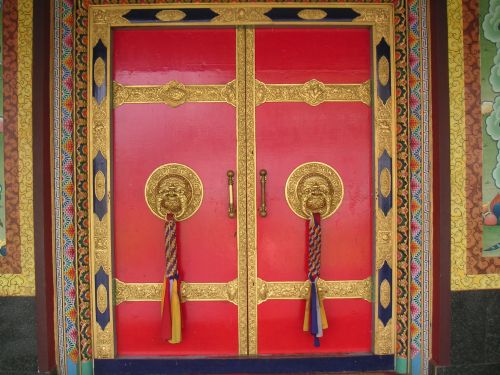
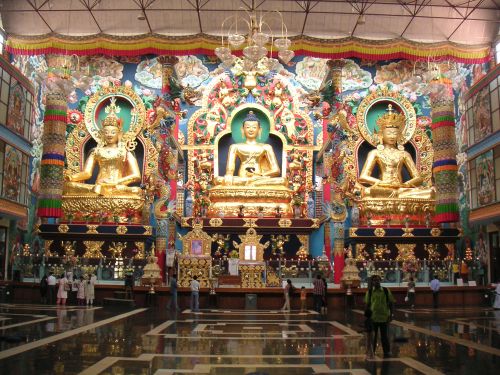


Peripatetic again
On 17th April I turned 27. Since this was the first time in my life that I was turning 27, I decided to do something different on the 17th. I had learned recently, from the trivia printed on polythene bag they give you at Landmark that Janis Joplin, Jim Morrison and Jimi Hendrix all died at 27. Now since I had (and have) no intentions of being part of this bit of fatal statistic, it ruled out all adventures which have potential of turning into misadventures. And so it was decided that I will take a two day KSTDC tour to Coorg. Besides docility (for they cater these days to families with kids on summer vacation), the merits of these tours include frugality (something I ultimately did not worry about for a kind friend sponsored the trip as a birthday gift – Thank You!) and relative hassle-freeness of overnight stay.
My journey started at 8:00 AM on 16th – some 45 minutes after the scheduled time. Some 90 minutes later we stopped at Channapatna near a small shop selling wooden toys and handicrafts (that this place is famous for). From there we resumed our drive towards Bylakuppe but stopped again at Maddur for 30 minutes, at insistence of fellow passengers demanding breakfast. The drive from Maddur was scenic. I was particularly fascinated by large areas of coconut plantations where sunlight and the shadows of the coconut canopies formed an interesting patchwork of darkness and light on the ground. A wagon loaded with gunny cement bags whizzed past my window. Three laborers, slept on this makeshift bed. Wind combing their scruffy, disheveled hair completed an idyllic picture. At that instant, I would have given anything to swap places with them. I was saddened greatly to see grand old trees being axed mercilessly for broadening the highway. Indeed, many goldmohur trees planted by the side of the road, were witnessing their last spring.
When we stopped at Namdroling monastery at Bylakuppe around 2:15, the drive had stretched for so long, that my first reaction was of disbelief at actually having arrived. The disbelief was to deepen upon seeing the beautifully painted oriental portal which let me into the monastery. The Tibetan monastery is dotted with several pagodas, the largest of them, the so called “Golden Temple”, had a beautiful, three-storey, oriental gilded roof. In front of this pagoda, smoke emanated from two squat towers, which was being fuelled by two monks periodically. Inside the temple, was a congregation of hundreds of monks, in their yellow and maroon habits, chanting prayers in a deep-throated voice. That, and the rhythmic beating of their traditional drums, bound me mesmerized to a single spot. My reverie broke when I realized that I was the only one standing. I scrammed, looked around frantically and figured that the cavalcade had moved to another pagoda.
Nothing had prepared me for what I saw at Padmasambhava Buddhist Vihara – the next pagoda that I visited. On entering the pagoda, through its bright red door that had an enormous gilded door-handle, I saw three golden statues, several feet tall. In center was the statue of Buddha and on its either side were statues of his disciples. The statues – though themselves plain in execution – were adorned with bright colorful murals on the wall behind them. Golden figurines were tacked to the edges of the backrest behind their thrones. They glittered in the afternoon sun. Despite being imposing by virtue of its dimensions, the edifice oozed infinite calm. On standing here one feels like a child who looses all his worldly worries as he rests his head in his mother’s lap. There were no overbearing priests and no restrictions on photography. A monk of the kindest countenance, seated at one end of the temple, kept a discreet watch without asserting his presence or authority. Sparrows chirped inside. They were joined by their enthusiastic chicks each time their mothers would fetch victuals. True to the principles of Buddhism, the sanctum of the pagoda was sanctuary to several families of sparrows.
What struck me most at the monastery was their usage of colors. Anywhere else, and those bright reds, blues, greens and gold would have seemed garish - even disturbing! But here, they were in perfect harmony with each other and their surroundings.
Unfortunately, such a place holds no promise for school kids on summer vacations. Thirty minutes is all that I got to spend there. While roaming around in the monastery premises, I had almost lost my way to the exit gate. Somehow – and I suspect more by providence than by my virtues – I finally emerged from the right gate, only to find the KSRTC bus absconding. After almost having lost my voice to panic, I managed to ask the haggard old guard prancing near the monastery gate the whereabouts of the bus. To my relief he simply pointed to the parking area and I boarded the bus just in time for our departure.
It’s 10:30 at night now. The electricity here plays havoc. It fluctuates in a manner which is more fickle than mind of capricious five-year old. And so I postpone writing this series to tomorrow. My dear readers, I hope that by now, you are used to my travelogues being doled out in installments :-).
My journey started at 8:00 AM on 16th – some 45 minutes after the scheduled time. Some 90 minutes later we stopped at Channapatna near a small shop selling wooden toys and handicrafts (that this place is famous for). From there we resumed our drive towards Bylakuppe but stopped again at Maddur for 30 minutes, at insistence of fellow passengers demanding breakfast. The drive from Maddur was scenic. I was particularly fascinated by large areas of coconut plantations where sunlight and the shadows of the coconut canopies formed an interesting patchwork of darkness and light on the ground. A wagon loaded with gunny cement bags whizzed past my window. Three laborers, slept on this makeshift bed. Wind combing their scruffy, disheveled hair completed an idyllic picture. At that instant, I would have given anything to swap places with them. I was saddened greatly to see grand old trees being axed mercilessly for broadening the highway. Indeed, many goldmohur trees planted by the side of the road, were witnessing their last spring.
When we stopped at Namdroling monastery at Bylakuppe around 2:15, the drive had stretched for so long, that my first reaction was of disbelief at actually having arrived. The disbelief was to deepen upon seeing the beautifully painted oriental portal which let me into the monastery. The Tibetan monastery is dotted with several pagodas, the largest of them, the so called “Golden Temple”, had a beautiful, three-storey, oriental gilded roof. In front of this pagoda, smoke emanated from two squat towers, which was being fuelled by two monks periodically. Inside the temple, was a congregation of hundreds of monks, in their yellow and maroon habits, chanting prayers in a deep-throated voice. That, and the rhythmic beating of their traditional drums, bound me mesmerized to a single spot. My reverie broke when I realized that I was the only one standing. I scrammed, looked around frantically and figured that the cavalcade had moved to another pagoda.
Nothing had prepared me for what I saw at Padmasambhava Buddhist Vihara – the next pagoda that I visited. On entering the pagoda, through its bright red door that had an enormous gilded door-handle, I saw three golden statues, several feet tall. In center was the statue of Buddha and on its either side were statues of his disciples. The statues – though themselves plain in execution – were adorned with bright colorful murals on the wall behind them. Golden figurines were tacked to the edges of the backrest behind their thrones. They glittered in the afternoon sun. Despite being imposing by virtue of its dimensions, the edifice oozed infinite calm. On standing here one feels like a child who looses all his worldly worries as he rests his head in his mother’s lap. There were no overbearing priests and no restrictions on photography. A monk of the kindest countenance, seated at one end of the temple, kept a discreet watch without asserting his presence or authority. Sparrows chirped inside. They were joined by their enthusiastic chicks each time their mothers would fetch victuals. True to the principles of Buddhism, the sanctum of the pagoda was sanctuary to several families of sparrows.
What struck me most at the monastery was their usage of colors. Anywhere else, and those bright reds, blues, greens and gold would have seemed garish - even disturbing! But here, they were in perfect harmony with each other and their surroundings.
Unfortunately, such a place holds no promise for school kids on summer vacations. Thirty minutes is all that I got to spend there. While roaming around in the monastery premises, I had almost lost my way to the exit gate. Somehow – and I suspect more by providence than by my virtues – I finally emerged from the right gate, only to find the KSRTC bus absconding. After almost having lost my voice to panic, I managed to ask the haggard old guard prancing near the monastery gate the whereabouts of the bus. To my relief he simply pointed to the parking area and I boarded the bus just in time for our departure.
It’s 10:30 at night now. The electricity here plays havoc. It fluctuates in a manner which is more fickle than mind of capricious five-year old. And so I postpone writing this series to tomorrow. My dear readers, I hope that by now, you are used to my travelogues being doled out in installments :-).
Abandon
Permanence
Pink!
Reading while eating
I find the act of eating extremely boring. Unfortunately it is compulsory for human survival and therefore unavoidable. Fortunately, one’s eyes and ears are available (during the course of a meal) for deployment to alternative activities that can make act of consumption of food enjoyable (actually so is one’s nose to some extent but I haven’t quite discovered ways in which the olfactory organ can be deployed for providing meaningful entertainment). In short, I find it necessary to pick a book while reading eating. Especially during dinners, when more often than not, I am devoid of any human company.
Victor Hugo’s Hunchback of Notre Dame has been keeping me company over lunches and dinners for over twenty days now. However, of late, I have had to keep the book aside and dedicate myself to sole consumption of food, for two reasons:
Here is one such life threatening passage from the book:
“According to the manner of that period, a Latin inscription on the wall, indicated to the lettered passer by the pious purpose of the cell. The custom was retained until the middle of the sixteenth century, of placing a brief explanatory motto above the entrance of the building. Thus in France, one reads over the wicket of the prison belonging ot the seigniorial mansion of Tourville, Sileto et spera (Be silent and hope); in Ireland, under the escutcheon placed above the great gate-way of Fortescue Castle, Forte sucum, salus ducum (Strong shield, the safety of lords); and in England, over the hospitable mansion of the Earls Cowper, Tumm est (It is thine). In those days, every edifice embodied a thought,.
As there was no door to the walled up cell of the Tour Roland, there had been carved in large Roman capitals, over the window, these two words:
TU, ORA
(Pray, thou). Hence the people, whose common sense sees not so many subtleties in things, but readily translates Ludovico Magno into Porte Saint Denis, gave to this dark, damp, dismal cavity the name of Troux aux Rats (signifying rat-hole) – an explanation less sublime than the other, but more picturesque”
Victor Hugo’s Hunchback of Notre Dame has been keeping me company over lunches and dinners for over twenty days now. However, of late, I have had to keep the book aside and dedicate myself to sole consumption of food, for two reasons:
- I get so engrossed in untangling the florid, filigreed writing (complete with generous sprinkling of Latin) of Monsieur Hugo that I risk losing my meal to voracious species of bacteria and fungi. But even before that happens, laws of thermodynamics take over - my food is robbed of all its warmth by its surroundings.
- For all its tedium, this is one classic that has brought me peals of laughter. When under a fit of what is also considered an essential medicine (laughter), my epiglottis, in gross dereliction of its duties, allows food particles to sneak into my windpipe, thus bringing about what is commonly called “choking”.
Here is one such life threatening passage from the book:
“According to the manner of that period, a Latin inscription on the wall, indicated to the lettered passer by the pious purpose of the cell. The custom was retained until the middle of the sixteenth century, of placing a brief explanatory motto above the entrance of the building. Thus in France, one reads over the wicket of the prison belonging ot the seigniorial mansion of Tourville, Sileto et spera (Be silent and hope); in Ireland, under the escutcheon placed above the great gate-way of Fortescue Castle, Forte sucum, salus ducum (Strong shield, the safety of lords); and in England, over the hospitable mansion of the Earls Cowper, Tumm est (It is thine). In those days, every edifice embodied a thought,.
As there was no door to the walled up cell of the Tour Roland, there had been carved in large Roman capitals, over the window, these two words:
(Pray, thou). Hence the people, whose common sense sees not so many subtleties in things, but readily translates Ludovico Magno into Porte Saint Denis, gave to this dark, damp, dismal cavity the name of Troux aux Rats (signifying rat-hole) – an explanation less sublime than the other, but more picturesque”
Hampi Visit - VI. Finale: IV. Grave
My feelings as I left Hampi, were that of indescribable loss and sadness. If this account by Robert Sewell is anything to go by, during the last days of Vijaynagar Empire, the people there lived through hell:
“With fire and sword, with crowbars and axes, they carried on day after day their work of destruction. Never perhaps in the history of the world has such havoc been wrought, and wrought so suddenly on so splendid a city; teeming with a wealthy and industrious population in the full plentitude of prosperity one day, and on the next seized, pillaged and reduced to ruins, among scenes of savage massacre and horrors beggaring description.”
I finally conclude my series of “Hampi” posts with a disturbing picture of the delicate, headless figurines (and a little verse which attempts to sum up their suffering). I would have loved to conclude on a lighter note, but sadly, the story of Vijaynagar had no happy endings.
the end
sun set on our kingdom’s fame
the night when those marauders came
we saw its fall; heads held in shame
and grisly dance of hungry flames
all part of their gruesome game
riot roistering murder shame
then those blows from hammers came
and sun set on our kingdom’s fame
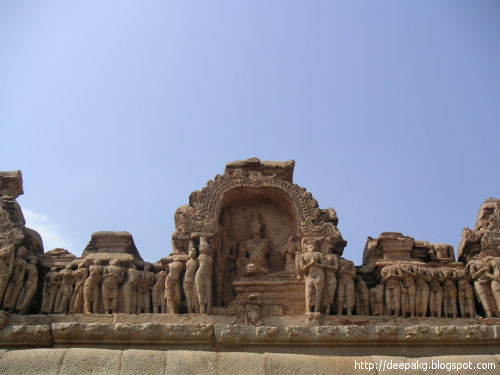
Here are the links to all the posts I’ve made till date recounting my experiences from the two day tour:
“With fire and sword, with crowbars and axes, they carried on day after day their work of destruction. Never perhaps in the history of the world has such havoc been wrought, and wrought so suddenly on so splendid a city; teeming with a wealthy and industrious population in the full plentitude of prosperity one day, and on the next seized, pillaged and reduced to ruins, among scenes of savage massacre and horrors beggaring description.”
I finally conclude my series of “Hampi” posts with a disturbing picture of the delicate, headless figurines (and a little verse which attempts to sum up their suffering). I would have loved to conclude on a lighter note, but sadly, the story of Vijaynagar had no happy endings.
the end
sun set on our kingdom’s fame
the night when those marauders came
we saw its fall; heads held in shame
and grisly dance of hungry flames
all part of their gruesome game
riot roistering murder shame
then those blows from hammers came
and sun set on our kingdom’s fame

Here are the links to all the posts I’ve made till date recounting my experiences from the two day tour:
- Hampi Visit - I. Preludio: Allegretto ma non troppo
- Hampi Visit - II. Andante con moto
- Hampi Visit - III. Allegro agitato
- Hampi Visit - IV. Adagio maestoso
- Hampi Visit - IV. Adagio maestoso (in pictures)
- Hampi Visit - V. Doppio Movimento
- Hampi Visit- V. Doppio Movimento (in pictures)
- Hampi Visit – VI. Finale: I. Allegro
- Hampi Visit – VI. Finale: I. Allegro (in pictures)
- Hampi Visit – VI. Finale: II. Presto
- Hampi Visit – VI. Finale: II. Presto (in pictures)
- Hampi Visit - VI. Finale: III. Scherzo
Hampi Visit - VI. Finale: III. Scherzo
As I was clicking the watch towers at the zenana, a lonely puff of cloud drifted across the sky and into my frame on an otherwise spotless sky. I sensed an uneasy tension between the two subjects of my picture. The tower which till now had stood meekly, telling its tale of woe to me, suddenly assumed an aggressive stance:.
Altercation
(I am a humble watch tower.
With no hands and no arms,
I never had much power)
For all your supernal charms
You would bring us no shower
I’ll let you pass with no harm
If you supplicate and cower
(With no hands and no arms,
I am a humble watch tower)
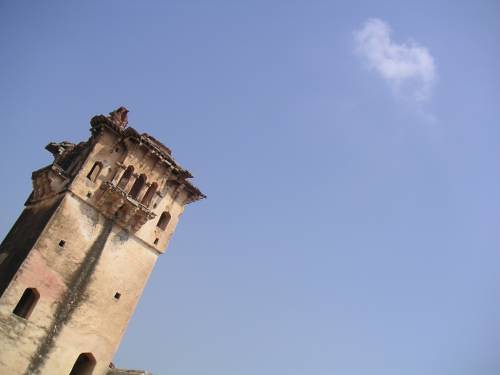
(The cloud cackled and continued its journey)
Altercation
(I am a humble watch tower.
With no hands and no arms,
I never had much power)
For all your supernal charms
You would bring us no shower
I’ll let you pass with no harm
If you supplicate and cower
(With no hands and no arms,
I am a humble watch tower)

(The cloud cackled and continued its journey)
Hampi Visit - VI. Finale: II. Presto (in pictures)
From Lotus Mahal, we moved on to the near by elephant stables – a row of domed, cavernous cells constructed back to back.
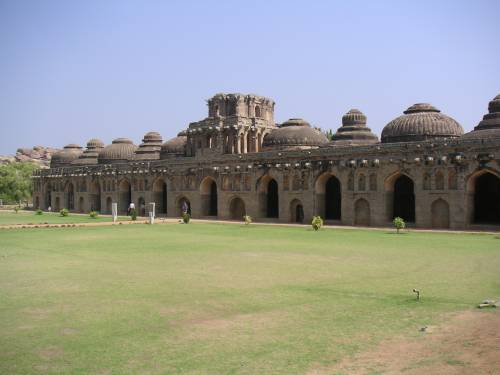
Each rock that is part of the Hazara Rama temple is engraved with a scene from Ramayana; which gives the temple its name (Hazara = 1,000).
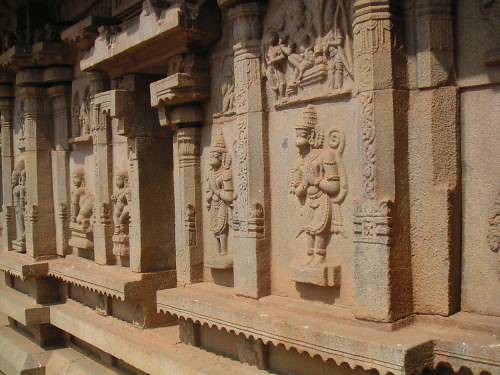
Nearby was one of the most well known sights from Hampi (next only to the stone chariot perhaps) – the Communal Bath. Pyramids of schist steps on all four sides lead you down into a progressively narrower area. Descending into this structure is like descending into an open inverted pyramid
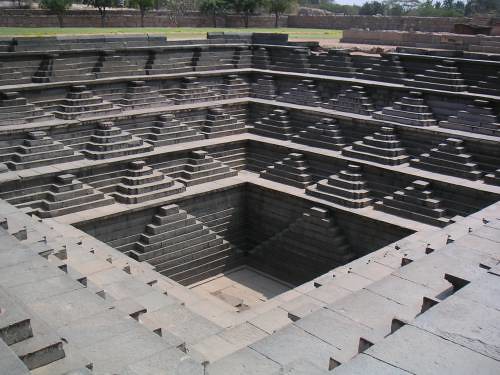
Outside the temple is a seemingly endless row of primitive, squat, open structures. This was another of the erstwhile popular bazaars that now lie in complete ruins.
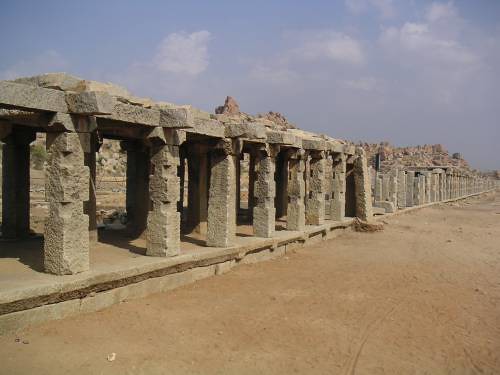

Each rock that is part of the Hazara Rama temple is engraved with a scene from Ramayana; which gives the temple its name (Hazara = 1,000).

Nearby was one of the most well known sights from Hampi (next only to the stone chariot perhaps) – the Communal Bath. Pyramids of schist steps on all four sides lead you down into a progressively narrower area. Descending into this structure is like descending into an open inverted pyramid

Outside the temple is a seemingly endless row of primitive, squat, open structures. This was another of the erstwhile popular bazaars that now lie in complete ruins.

Hampi Visit - VI. Finale: II. Presto
From Lotus Mahal, we moved on to the near by elephant stables – a row of domed, cavernous cells constructed back to back. The time we live in, it is easier for me to visualize a hanger hangar than an elephant stable. Quite naturally, I stood inside one and marveled at its high ceiling and cool dark interiors. In hindsight, it feels a little foolish to have expended so much time at what must have been an elephant’s slovenly quarters.
The sun had greatly wearied me by this time. Under a tree in the lawns of the elephant stables, coconut water was being sold and was in much demand. The coconut-peddler demonstrated speed and accuracy of a well-trained sniper in hacking at the coconuts with his sickle. The force of his assault would occasionally cause a few drops of coconut water to spill on the customers standing nearby; though no one seemed to mind that welcome spray. Two helpings of coconut water bolstered me for our next stop – the Hazara Rama temple.
Each rock that is part of the Hazara Rama temple is engraved with a scene from Ramayana; which gives the temple its name (Hazara = 1,000). No matter which nook or corner I looked at, I would find something that would astound me with its details. A few minutes here and one begins to wonder if the rocks would come to life and start talking. Ironically it was here that I saw some of the most shocking examples of brutal, senseless destruction that the attackers had unleashed centuries ago. It would be impossible for me to forget that row of delicately sculptured supplicant human figurines, decorating one of the entrance gates; their heads knocked off grotesquely by pickaxe of a nonchalant vandal.
What I saw next was easily the most humbling of sights at Hampi. As I stood on a raised floor, the only tangible remains of what was once either an assembly hall, or a court, or according our guide, the King’s palace, I couldn’t help but ponder on future of our modern glass concrete structures. There were evenly placed square cavities in the floor, that must have once held beams (according to the version prevalent – they were sandalwood beams) that supported, what must’ve been, an enormous roof. There was a small underground cellar attached to the ‘palace’ and is considered to be a secret meeting room for the king. Two elephants, carved out of black stone, were placed one either side of a small staircase that led us to another such platform (remains of a house or palace) in the vicinity. Tapping them gently with my knuckles produced a surprisingly metallic sound. Others used stones instead of their knuckles to the same (if amplified) effect – I couldn’t get myself to do it.
Nearby was one of the most well known sights from Hampi (next only to the stone chariot perhaps) – the Communal Bath. Pyramids of schist steps on all four sides lead you down into a progressively narrower area. Descending into this structure is like descending into an open inverted pyramid. I am not sure if the bath was assembled piecemeal or carved out of one big rock – it is an immaterial detail that wouldn’t make the structure any less interesting. Ironically again – the structure had lain buried under soil and stones for many years. Had you visited Hampi just three decades ago, a stone aqueduct ending abruptly into flat ground is all you would have seen.
In the same general area was the high podium called Mahanavami Dibba and from here, the king presided over the annual Dushera celebrations. The base of the Dibba is tastefully engraved and I saw at least one paneling that looked as if it was done in ivory – owing to its cream color (everything else around it was black). I climbed the roofless podium. From this height, for the first time, Hampi felt like an archeological site (remarkably like those underexposed, black and white pictures of Harappan excavations we saw in our history textbooks as kids). Except for the communal bath, everything here was in total disarray. I could see floors, basements and collapsed walls but nothing that would count as anything remotely habitable. Till now Hampi, thanks to the relative ‘completeness’ of the structures here, had given impression of a small medieval Indian town abandoned en masse in a hurry. The structures, despite the assault of nature’s cruel devices (and that of invaders) had looked strong and livable – not once did they appear so vulnerable.
My camera’s battery suddenly went dead thereby rendering it as useful as stones scattered all around me (one can perhaps invent cleverer uses for the stones as those fine specimens from stone-age would rightly prove. In fact we owe the discovery of fire and therefore furthering of the human race to these stones. Not to mention their glorious contributions to the English language in wonderful adjectives such as “stoned”, “stone-dead”, “stone-deaf” etc. I shall stop my discourse and come to the point for I risk turning this travelogue into an ode to stones). We were due for lunch at the guesthouse, and the sudden prospect of being able to charge my battery there, had a multiplicative effect on my appetite. Alas, we were first herded to Queen’s Bath - whose purpose is quite amply explained by its name and of its construction there is little that I remember. It wasn’t of-course anything as dramatic as the Communal Bath, though absence of my camera contributed greatly to my general lack of interest in the structure (and the subsequent selective amnesia that now shrouds my Hampi memories).
Lunch was an hour long affair. Thanks to the power failure at the guesthouse my camera’s battery could obtain its electron rich diet from the mains for only forty minutes. (It had to be placed on a molded plastic chair near the door of the guesthouse canteen. I was sitting almost at the other end of the room and managed a meal while keeping an unblinking eye on the unblinking red indicator of the battery charger).
We started quite late into the afternoon towards the Vittala Temple. This temple complex houses some of the most popular monuments at Hampi. There is the large riveting chariot in the temple’s courtyard whose wheels are carved out in such a way that they turn on their stone axles and thus attract adults and children alike.
Several parties were touring the complex at that time; each had a guide who wore a whistle around his neck and blew it loudly to catch his respective party’s attention - like a football referee all ready to issue a red card to an unruly player. Each guide required his groups’ attention so often and in such tandem with the other that you couldn’t tell who was calling for whom.
Other big attraction in the Vittala complex is the pillars of the temples here. They emit musical notes on being struck, and though officially one is not supposed to strike them (for it wears them) - the decree had little impact on most visitors. The pillars bear a dark, worn look at their centers from repeated beatings. I suspect a lot of “non-musical” pillars, thanks to their prodigious musical neighbors, are routinely tapped too - in hope of coercing a stray note of the octave from them. The temples here are probably illuminated at night – it would be hard for me to explain the electric wires and lights that I saw on the temple floor otherwise.
A group of excited school children from the near by village sat on the temple staircase posing for a group photograph. Their bright, colorful dresses stood out in awkward contrast to the stolid backdrop. A gnarled, leafless tree to their right, presented an appearance so consistent with the ruins that I wondered if it was a result of years of attempted camouflage.
The temple had now started getting crowded and noisy so I broke off from our group and strayed out of the temple complex. Outside the temple is a seemingly endless row of primitive, squat, open structures. This was another of the erstwhile popular bazaars that now lie in complete ruins.
Our Hampi trip concluded with a perfunctory visit to the Hampi Museum. A Museum? At Hampi? Isn’t the entire site one colossal museum? These were my sentiments too though I later realized that a museum does have its place there. It houses historically important articles such as utensils, weapons, coinage and idols recovered during excavation. You can also study a brief photographic history of the archeological work at Hampi (for instance, you can see what the site of present day communal bath looked like before its discovery). Sadly photography was prohibited inside the museum and the time allotted to our museum visit was hardly conducive to note-taking.
We left Hampi at 4:15 in the evening. I cannot think of another place that had left a profounder impression on me. I might be done with my account of Hampi, but I am scarcely done with Hampi itself. The ruins of the Vijaynagar Kingdom call me back – a call I hope to answer very soon.
The sun had greatly wearied me by this time. Under a tree in the lawns of the elephant stables, coconut water was being sold and was in much demand. The coconut-peddler demonstrated speed and accuracy of a well-trained sniper in hacking at the coconuts with his sickle. The force of his assault would occasionally cause a few drops of coconut water to spill on the customers standing nearby; though no one seemed to mind that welcome spray. Two helpings of coconut water bolstered me for our next stop – the Hazara Rama temple.
Each rock that is part of the Hazara Rama temple is engraved with a scene from Ramayana; which gives the temple its name (Hazara = 1,000). No matter which nook or corner I looked at, I would find something that would astound me with its details. A few minutes here and one begins to wonder if the rocks would come to life and start talking. Ironically it was here that I saw some of the most shocking examples of brutal, senseless destruction that the attackers had unleashed centuries ago. It would be impossible for me to forget that row of delicately sculptured supplicant human figurines, decorating one of the entrance gates; their heads knocked off grotesquely by pickaxe of a nonchalant vandal.
What I saw next was easily the most humbling of sights at Hampi. As I stood on a raised floor, the only tangible remains of what was once either an assembly hall, or a court, or according our guide, the King’s palace, I couldn’t help but ponder on future of our modern glass concrete structures. There were evenly placed square cavities in the floor, that must have once held beams (according to the version prevalent – they were sandalwood beams) that supported, what must’ve been, an enormous roof. There was a small underground cellar attached to the ‘palace’ and is considered to be a secret meeting room for the king. Two elephants, carved out of black stone, were placed one either side of a small staircase that led us to another such platform (remains of a house or palace) in the vicinity. Tapping them gently with my knuckles produced a surprisingly metallic sound. Others used stones instead of their knuckles to the same (if amplified) effect – I couldn’t get myself to do it.
Nearby was one of the most well known sights from Hampi (next only to the stone chariot perhaps) – the Communal Bath. Pyramids of schist steps on all four sides lead you down into a progressively narrower area. Descending into this structure is like descending into an open inverted pyramid. I am not sure if the bath was assembled piecemeal or carved out of one big rock – it is an immaterial detail that wouldn’t make the structure any less interesting. Ironically again – the structure had lain buried under soil and stones for many years. Had you visited Hampi just three decades ago, a stone aqueduct ending abruptly into flat ground is all you would have seen.
In the same general area was the high podium called Mahanavami Dibba and from here, the king presided over the annual Dushera celebrations. The base of the Dibba is tastefully engraved and I saw at least one paneling that looked as if it was done in ivory – owing to its cream color (everything else around it was black). I climbed the roofless podium. From this height, for the first time, Hampi felt like an archeological site (remarkably like those underexposed, black and white pictures of Harappan excavations we saw in our history textbooks as kids). Except for the communal bath, everything here was in total disarray. I could see floors, basements and collapsed walls but nothing that would count as anything remotely habitable. Till now Hampi, thanks to the relative ‘completeness’ of the structures here, had given impression of a small medieval Indian town abandoned en masse in a hurry. The structures, despite the assault of nature’s cruel devices (and that of invaders) had looked strong and livable – not once did they appear so vulnerable.
My camera’s battery suddenly went dead thereby rendering it as useful as stones scattered all around me (one can perhaps invent cleverer uses for the stones as those fine specimens from stone-age would rightly prove. In fact we owe the discovery of fire and therefore furthering of the human race to these stones. Not to mention their glorious contributions to the English language in wonderful adjectives such as “stoned”, “stone-dead”, “stone-deaf” etc. I shall stop my discourse and come to the point for I risk turning this travelogue into an ode to stones). We were due for lunch at the guesthouse, and the sudden prospect of being able to charge my battery there, had a multiplicative effect on my appetite. Alas, we were first herded to Queen’s Bath - whose purpose is quite amply explained by its name and of its construction there is little that I remember. It wasn’t of-course anything as dramatic as the Communal Bath, though absence of my camera contributed greatly to my general lack of interest in the structure (and the subsequent selective amnesia that now shrouds my Hampi memories).
Lunch was an hour long affair. Thanks to the power failure at the guesthouse my camera’s battery could obtain its electron rich diet from the mains for only forty minutes. (It had to be placed on a molded plastic chair near the door of the guesthouse canteen. I was sitting almost at the other end of the room and managed a meal while keeping an unblinking eye on the unblinking red indicator of the battery charger).
We started quite late into the afternoon towards the Vittala Temple. This temple complex houses some of the most popular monuments at Hampi. There is the large riveting chariot in the temple’s courtyard whose wheels are carved out in such a way that they turn on their stone axles and thus attract adults and children alike.
Several parties were touring the complex at that time; each had a guide who wore a whistle around his neck and blew it loudly to catch his respective party’s attention - like a football referee all ready to issue a red card to an unruly player. Each guide required his groups’ attention so often and in such tandem with the other that you couldn’t tell who was calling for whom.
Other big attraction in the Vittala complex is the pillars of the temples here. They emit musical notes on being struck, and though officially one is not supposed to strike them (for it wears them) - the decree had little impact on most visitors. The pillars bear a dark, worn look at their centers from repeated beatings. I suspect a lot of “non-musical” pillars, thanks to their prodigious musical neighbors, are routinely tapped too - in hope of coercing a stray note of the octave from them. The temples here are probably illuminated at night – it would be hard for me to explain the electric wires and lights that I saw on the temple floor otherwise.
A group of excited school children from the near by village sat on the temple staircase posing for a group photograph. Their bright, colorful dresses stood out in awkward contrast to the stolid backdrop. A gnarled, leafless tree to their right, presented an appearance so consistent with the ruins that I wondered if it was a result of years of attempted camouflage.
The temple had now started getting crowded and noisy so I broke off from our group and strayed out of the temple complex. Outside the temple is a seemingly endless row of primitive, squat, open structures. This was another of the erstwhile popular bazaars that now lie in complete ruins.
Our Hampi trip concluded with a perfunctory visit to the Hampi Museum. A Museum? At Hampi? Isn’t the entire site one colossal museum? These were my sentiments too though I later realized that a museum does have its place there. It houses historically important articles such as utensils, weapons, coinage and idols recovered during excavation. You can also study a brief photographic history of the archeological work at Hampi (for instance, you can see what the site of present day communal bath looked like before its discovery). Sadly photography was prohibited inside the museum and the time allotted to our museum visit was hardly conducive to note-taking.
We left Hampi at 4:15 in the evening. I cannot think of another place that had left a profounder impression on me. I might be done with my account of Hampi, but I am scarcely done with Hampi itself. The ruins of the Vijaynagar Kingdom call me back – a call I hope to answer very soon.
Hampi Visit - VI. Finale: I. Allegro (in pictures)
We halted first at the Kadlekalu Temple - the larger of the two Ganesha temples (the second one being Sasivekalu). The temple portico was supported by several beautifully carved stone pillars.
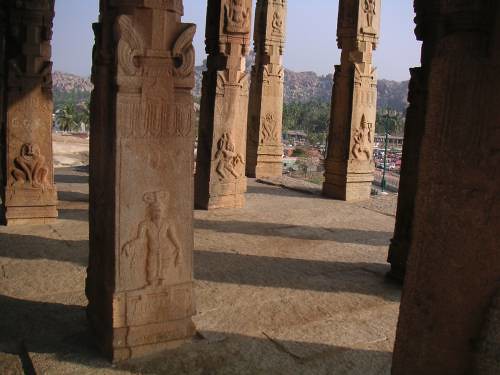
The sanctum houses a large – and now severely damaged – monolithic idol of the deity. The callousness, with which Ganesha’s trunk and belly had been destroyed, left on me an impression that still haunts me
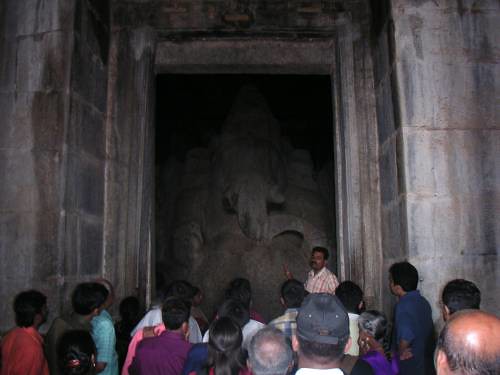
Also visible from here was the stunning light-yellow gopurum of the Virupaksha temple which looked somewhat out of place among the rusty/grey stone ruins
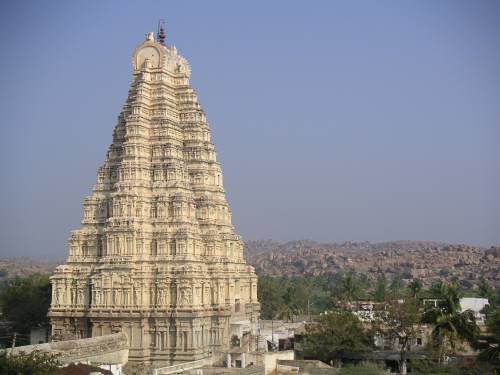
Prayers and other religious ceremonies are conducted here to date. We descended down the Kadlekalu temple and soon found ourselves at the portal of the Virupaksha temple. A closer inspection of the gopuram revealed that it was every bit from the same kernel (and time period) as the rest of the structures – the light yellow color was but result of zealous application of whitewash.
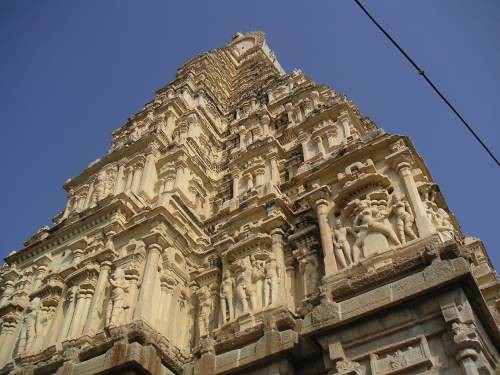

Another monkey was perched atop one such wall and was enjoying a coconut that it had probably pilfered from the temple. It drew considerable attention from tourists around me which it handled with candor of a newsreader reading his thousandth news bulletin.
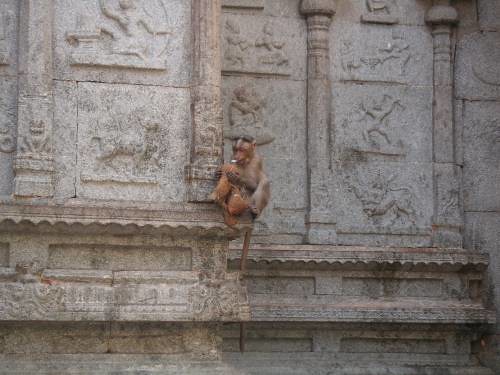
From there we moved to another imposing monolith – that of Narsimha, the lion-faced reincarnation of Vishnu, seated cross-legged on his serpent Adisesha. The statue has been restored extensively. A belt of stone that joins the two knees of the statue was apparently added recently for the statue’s structural stability. The painted iron gate tacked to the enclosure around the statue is unmistakably a 20th century addition.
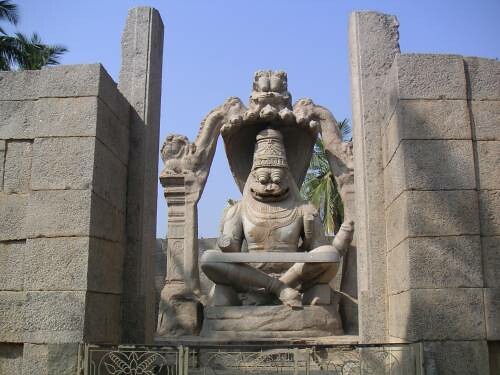
Our next stop was the zenana enclosures that are said to have housed the women of royal lineage. There were tall watchtowers in the compound with somewhat elaborate balconies that probably allowed the women a glimpse of the outside world.
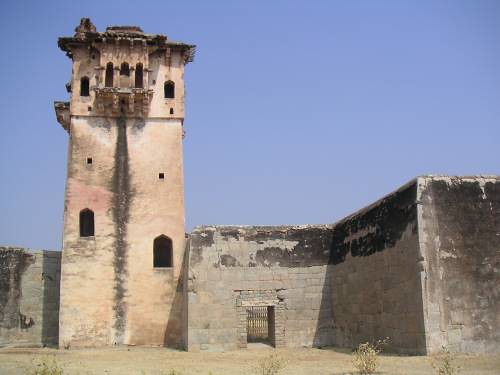
In one corner of the zenana was the intricate two story open pink structure called the Lotus Mahal. There were elaborately carved portals on each side of the structure that had something very Saracenic about them. It is not known what Lotus Mahal was used for – though for some unfounded reasons I could visualize a classical dance performance in the Mahal’s verandah on a late summer evening centuries ago. I fancy sitting here alone with a book on a rainy monsoon day.
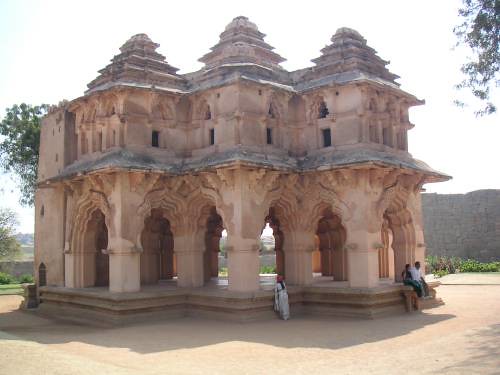

The sanctum houses a large – and now severely damaged – monolithic idol of the deity. The callousness, with which Ganesha’s trunk and belly had been destroyed, left on me an impression that still haunts me

Also visible from here was the stunning light-yellow gopurum of the Virupaksha temple which looked somewhat out of place among the rusty/grey stone ruins

Prayers and other religious ceremonies are conducted here to date. We descended down the Kadlekalu temple and soon found ourselves at the portal of the Virupaksha temple. A closer inspection of the gopuram revealed that it was every bit from the same kernel (and time period) as the rest of the structures – the light yellow color was but result of zealous application of whitewash.


Another monkey was perched atop one such wall and was enjoying a coconut that it had probably pilfered from the temple. It drew considerable attention from tourists around me which it handled with candor of a newsreader reading his thousandth news bulletin.

From there we moved to another imposing monolith – that of Narsimha, the lion-faced reincarnation of Vishnu, seated cross-legged on his serpent Adisesha. The statue has been restored extensively. A belt of stone that joins the two knees of the statue was apparently added recently for the statue’s structural stability. The painted iron gate tacked to the enclosure around the statue is unmistakably a 20th century addition.

Our next stop was the zenana enclosures that are said to have housed the women of royal lineage. There were tall watchtowers in the compound with somewhat elaborate balconies that probably allowed the women a glimpse of the outside world.

In one corner of the zenana was the intricate two story open pink structure called the Lotus Mahal. There were elaborately carved portals on each side of the structure that had something very Saracenic about them. It is not known what Lotus Mahal was used for – though for some unfounded reasons I could visualize a classical dance performance in the Mahal’s verandah on a late summer evening centuries ago. I fancy sitting here alone with a book on a rainy monsoon day.

| Archives | Blogroll |
|
May 2003 | June 2003 | July 2003 | August 2003 | September 2003 | October 2003 | November 2003 | December 2003 | January 2004 | February 2004 | March 2004 | April 2004 | May 2004 | June 2004 | July 2004 | August 2004 | September 2004 | October 2004 | November 2004 | December 2004 | January 2005 | February 2005 | March 2005 | April 2005 | May 2005 | June 2005 | July 2005 | August 2005 | September 2005 | October 2005 | November 2005 | December 2005 | January 2006 | February 2006 | March 2006 | Current Posts |
All material posted on this blog is copyrighted and may not be used in any form without the explicit permission of the author.
